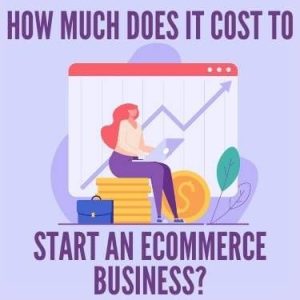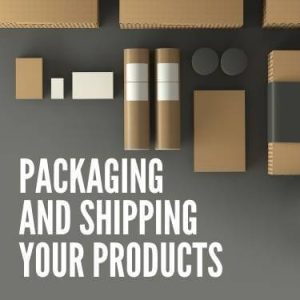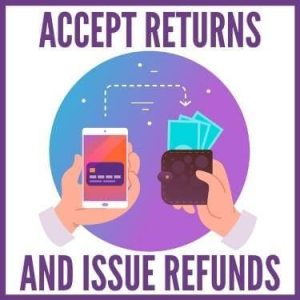
 Copy URL to Clipboard
Copy URL to Clipboard
Want to learn how to start an eCommerce business? More than half of all American consumers prefer to shop online instead of in stores, and that number only goes up if you look at younger generations. There’s a massive opportunity for entrepreneurs and potential business owners in the online world, but it can be challenging to know how to get started.
To start an eCommerce business, you’ll need to start with a good plan, find a product that sells, design a user-friendly website, and use marketing strategies to advertise your store. Once things pick up, you’ll need to worry about packaging and fulfillment, customer satisfaction, and the steps to take to expand your business.
When you reach the stage of your business where you need assistance with warehousing and product fulfillment, R+L Global Logistics is here to help. Our fulfillment experts will create an individualized plan to meet your unique needs. You can reach out to our team at (866)989-3082. We’ll go over available options and answer all of your questions.
To learn more about starting an ecommerce business, use our comprehensive guide below.
Table of Contents

The online shopping industry was worth $3.5 trillion in 2019, and has followed a trend of exponential growth for years! eCommerce is a lucrative business opportunity with the potential for high rewards, but it isn’t free to get started. As with any business, there will be upfront costs to get your business off the ground. There is good news, however! The costs of starting an online business are much lower than starting a brick-and-mortar store!
Getting started with online retail isn’t exactly free, but you can expect to pay a lot less upfront than most other business models. Here are some of the expenses you can expect when starting an eCommerce business:
As a comparison, the cost of starting a brick-and-mortar store is usually more than $100,000!

If you don’t know what you want to sell yet, you should know that there are a few things you’ll want to look out for when selecting the right product. Not just any trinket will work and exploring a variety of different business ideas can be beneficial.
First, to narrow down a list of potential digital or physical products, consider what you’re passionate about — or at least mildly interested in. It will be easier to stand behind a product if it is something you actually care about. Here are some other pointers to help you find some product ideas to sell online:
Don’t be afraid of selling a niche product. You could make lots of money by selling accessories for other products online, as long as the demand is there.

A business model describes how you intend to run your business, deliver value, and generate revenue. It is the center of your business plan. eCommerce is a business model already, but there are still ways you can make that more specific.
What will the day-to-day operations of your business look like? Will you be selling imported goods? Dropshipping? Hand making your products? Utilizing multi-level marketing?
As you can probably tell, there are countless effective business models, but you have to find the one that matches your goals. If you intend to work alone, multi-level marketing or more traditional business models might not work well for you.
If you are setting up an online store for an existing retail location, then you would have a bricks-and-clicks model. You may also consider using your retail location for storage for your online store, or you could offer local delivery and pickup for online orders from your retail location.
Once you have a model, you need to create a business plan to execute it. Business plans are not just for entrepreneurs looking for investors. A business plan can keep you on target for completing your goals and help you to see the viability of your business before you get started. If you have multiple ideas, creating a business plan for each can help you compare options and pick the one that works best.
Creating a business plan requires a lot of research. To make a plan, you will want to consider:
Creating a thorough business plan before you get too invested in your idea is vital. You may get halfway through your plan and realize you don’t have everything quite as figured out as you thought you did. Finding the kinks in the strategy early on is key to avoiding failure in the future.
This is an overlooked yet crucial aspect of forming any kind of new business, including one in the eCommerce space. When making this decision, you’ve already decided on an eCommerce operation — the business type here refers to how your business is viewed in terms of tax purposes, the number of employees, benefits and even the company’s liability in terms of accumulating debt.
While there are more than these, the most frequent designations for a business are:
Many smaller businesses might be attracted to the ease that comes with being classified as a sole proprietor or partnership, since the state you are conducting your business in will automatically register you as such. A corporation is often considered to be a bigger entity with many employees and stockholders. As a nascent eCommerce business, it’s very unlikely you’ll be categorized this way until you’ve done quite a bit of growing.
So let’s quickly look at what being a sole proprietor/partnership or an LLC entails.
Sole proprietor/partnership: Like it said above, a sole proprietorship is the least complex setup but doesn't draw a line between the person and the business. What this means is that any legal matter, even if it’s in regard to paying the proper taxes, is the responsibility of the person running the business. In this scenario, this means the individual can be held liable for anything the company does wrong and the liability that can be incurred is unlimited. Also, if you require a loan as capital to start the business, it may be more difficult to secure funding as a sole proprietor.
However, there are advantages. As previously stated, they are easy to form. The other appealing aspect is that as the sole proprietor or partnership, the people who own the business reap all of the business’ profits.
LLC: For both tax and legal purposes, many eCommerce businesses might choose to operate as an LLC or Limited Liability Corporation. What this means, in a nutshell, is that the company can be sued and have judgment rendered against it in a legal matter. But the person who owns the LLC can’t have their personal assets seized as part of a court decision. An eCommerce business is allowed to register as an LLC, whether as an individual, a partnership or even a corporation.

Now that you have a product, a model, and a plan, you need to find a supplier for your products. There are many ways to find suppliers, but one of the easiest ways is to reach out to a foreign supplier through sites like Alibaba. However, if the thought of importing foreign goods is too intimidating, or against your values, then you can find domestic distributors just as easily!
If you intend to use a dropshipping business model, then you will need to establish that relationship with your supplier. Not all suppliers offer dropshipping services, so make sure the company you are working with does what you need it to.
If the product you are trying to source is a brand new original idea, then you’re going to need to find a manufacturer to create your products. The best way to find a manufacturer is to search through online directories like Kompass or ThomasNet. Like with distributors, you can choose to work with a domestic or international partner.
Regardless of whether you are dropshipping, calculating inventory tax, or working with a third-party warehouse, you need to know how much inventory you have at any given time. If a product is out of stock, that needs to be reflected in your store. The last thing you want is to have to tell a customer an item is out-of-stock after they’ve already paid.
If you’re dropshipping, you need to be in constant communication with your supplier about their inventory levels. Having an automated system in place that integrates with your online store is an excellent way of keeping your website up to date on the latest stocking information. Still, that functionality isn’t going to be an option with all suppliers. If your supplier is out of something, you need to know.
Even if you plan on keeping track of your own inventory, things can get lost, overlooked, or miscounted. Keep an updated spreadsheet of your entire inventory, and make sure to recount your stock periodically to make sure you keep the most accurate count possible.
Working with a Third-Party Logistics company (3PL) for your warehousing needs is the best option if you can manage it. The responsibility of keeping track of inventory would be out of your hands, so that would free up a lot of your time. Many 3PLs also integrate their warehouse stock with your website with the help of advanced Warehouse Management Systems (WMS). Additionally, when product stock begins to get low, you can even have your 3PL communicate with your supplier on your behalf to restock before the inventory runs out.

Now, it’s time for you to think about one of the most critical aspects of your online business: your eCommerce website. Your website is like your storefront; it is your eCommerce platform that allows you to sell online. It needs to draw customers in, be aesthetically pleasing, and look professional. It should also be easy to navigate, branded, and well-organized. If your website isn’t user friendly, potential buyers might bounce before ever making a purchase.
Creating a website from scratch is easier now than ever before, with applications like Wix and WordPress. However, there is a lot that goes into making a website look good and operate well. You’ll need to design a logo, the site layout, colors, and much more. Meanwhile, you’ll also have to worry about the technical aspect of building a website, as well as security and reliability.
Make sure your product pages are uncluttered and easy to navigate. You should clearly display prices and product specs, and it’s usually a good practice to recommend other similar products on product pages to encourage more sales. In addition to that, make sure you are prepared to accept multiple different payment options, like PayPal, credit cards, or bank transfers. Remember, if you plan to sell internationally, customers from other parts of the world may prefer different payment options.
When your entire business is dependent on the success of your website, you might just want to consider leaving its development in the hands of the professionals.
One way to find a good web developer is to find independent online stores that you like the look of and reach out to them to ask who designed their website. If they had someone in-house create it, you may be out of luck. But if they worked with an independent developer, then you could reach out to them to inquire about making your own site. After all, you can see the work that they’ve done on the other site, and you know that they’ll deliver results.
You should probably steer clear of sites like Fiverr or other freelance sites. Always work with a developer that someone else recommends. Otherwise, you might get scammed.
It is essential to understand that your website must stay relevant and up-to-date on the latest web trends. You can’t expect to succeed with a website that looks like it’s dated from the early 2000s. Not only that, but you should always be on the lookout for ways to optimize your site to increase conversions and keep people on your site longer.
At this point, you have a website, a product, and a plan. All you need now is to attract customers to your eCommerce store. People aren’t going to seek you out, so you need to find a way to bring customers to you. However, there isn’t a perfect marketing solution that’s going to work for everyone.
Thankfully, there are countless different ways to advertise your store, like with:
You should try to keep your marketing strategy diverse. Utilize many different marketing techniques to reach the widest audience possible, and then, once you have an audience, keep them coming back with memberships, email lists, and other incentives.
One way to encourage customers to shop with you again is to offer a point system to those who sign up for a membership on your site. Customers can accumulate points for each dollar they spend with you, and then redeem those points later for discounts, free items, or other perks. You can even have a tiered point system, so you can offer better rewards to customers who accumulate points above a certain threshold.
For example, Ulta has three tiers for their rewards members: Member, Platinum, and Diamond. Members receive 1 point per dollar spent, Platinum Members receive 1.25 points per dollar spent, and Diamond Members receive 1.5 points per dollar spent. Those points can then be redeemed for steep discounts on products. Making it to Diamond Member status also comes with additional benefits for the customer, such as exclusive coupons, free shipping, and an annual gift card from the company.
Other options for retaining customers are by offering coupons, discounts, promo codes, freebies, bonuses for referring friends, and personalized emails and other marketing materials per customer account.

Once you start making sales, you need a plan to stay organized while shipping orders out as quickly as possible. You should always keep track of every order that you receive. Even if you only get an average of one order a day, it is important to get into the habit of writing everything down.
Better yet, you should look into software that could integrate with your website and keep track of orders for you, just to make sure nothing slips through the cracks. That way, you would be able to see everyone who has made an order, as well as precisely what they ordered. You can also reduce picking errors by using that as a reference when packing boxes.
In addition to the logistical challenges of managing a high volume of orders, you should also consider personalizing your boxes to make the most of them. While some companies might see a regular box, you should see the potential: six sides that you can use to personalize your customer’s experience and improve your brand recognition. Here are some ideas to make your boxes themselves more memorable for your customers:
Alternatively, if packaging and shipping orders is taking up too much of your time, there’s another convenient option: outsourcing. Making the decision to outsource any part of your business is nerve wracking, but at a certain point, it becomes difficult to do everything yourself. Order fulfillment is one of the most time-consuming aspects of running an eCommerce store, so you could end up getting a lot more accomplished if you didn’t have to worry about it.
The best option for outsourcing fulfillment work is with a 3PL. You could hire an employee to do the work for you, but in general, it’s a lot more affordable and convenient to work with a company like R+L Global Logistics.
Not only can a 3PL store your products and ship orders to customers, but they can also offer value-added services you might not have been able to offer before, like expedited shipping, or even free shipping. Plus, if you were using personalized boxes or packaging inserts before, you can continue to use them even if you switch to fulfilling orders with a 3PL.

Things could be running smoothly up until a customer decides they want to return a product. The rate of returns depends a lot on the type of product being sold and the cost of the items. Clothing and shoes are returned extremely frequently, while small, inexpensive trinkets are returned less often. And of course, anything that arrives broken will almost always be returned.
The process of managing returns is called Reverse Logistics because goods move backward through the supply chain. As an eCommerce business owner, you have to be prepared to accept these return shipments. In addition to that, you need to be able to refund unsatisfied customers or send out replacement shipments. Although you aren’t legally required to refund unsatisfied customers, not doing so will almost guarantee that customer never buys from you again.
Returns are a pain to deal with. They’re expensive, time-consuming, and could potentially cost you customers if they aren’t handled well. This is another good reason to consider outsourcing fulfillment to a 3PL, so you can hand this headache off to someone else. A good fulfillment partner can not only accept returns on your behalf, but they can also help you reclaim the value of your returned products by sending them off for repairs, repackaging them, and reselling them.
If you can manage to accept returns in a timely manner and offer a good deal to your unsatisfied customer, you may even be able to turn their negative experience into a positive one with customer service that goes above and beyond.

The goal of any business owner is to grow their business. Maybe you want to be the go-to source for a particular type of product, or maybe you want to make more money. Maybe you just want to live a modest lifestyle off your eCommerce sales. No matter how you want to grow, or why, you should know that managing your store is a task that is going to become too much to handle.
It can be tempting to try to control everything in your business. It’s hard to trust others, and you can’t be sure that everyone who works for you is going to care as much as you do about the company. However, if you want to let your company grow, you can’t maintain a stranglehold on every aspect of it. You need to be able to let go of some control and hand the day-to-day responsibilities off to others so that you can focus on growth.
Fulfillment is the first step of many that you can take to free up your time, and it’s an easy choice. By working with R+L Global Logistics, you know that you’ll be working with a professional company with a good reputation, so you won’t have to worry about putting your business in the wrong hands. We’ll care about your business, and we’ll treat your customers as if they are our own.
By outsourcing your fulfillment with a 3PL, you’ll be able to maintain complete control over the process without having to waste your time on busy-work. Plus, it’ll be a good exercise in passing on responsibility to others, so you’ll be more prepared to hand over aspects of your business to employees when the time comes.
R+L Global Logistics offers a range of fulfillment and distribution services. No matter what your business requires, we have solutions that can fit your needs. If you need to store 10 pallets, 100 pallets, or even more than that, we can offer warehouse space around the country. We work with countless vetted partners to be able to provide you with refrigerated warehousing, expiring product fulfillment, and much more!
To better serve our eCommerce partners, we offer services like Pick and Pack fulfillment to make the order fulfillment process more personalized and efficient. We carefully pack one box with all the items a customer orders, along with any packaging inserts you may want to include, and ship them off to the customer on your behalf.
By using a single box, no matter how many items a customer buys, you can reduce packaging and shipping costs and make the experience more convenient for your customers.
We can also offer specialized Kitting and Assembly services that allow you to sell multiple different items together as a bundle, often at a slight discount. This can help you upsell to your customers by bundling items that are commonly purchased together.
If you sell bathroom products, you could bundle all your products with similar scents together, such as lavender hand soap, lotion, and face scrubs. Or, if you sell bags, you could bundle together bags with the same pattern to make a luggage kit for people who travel frequently.
In addition to those services, we also offer:
If you’re just getting the hang of how to start an eCommerce business, R+L Global Logistics can help you set up your fulfillment and distribution at an affordable price. Give us a call at (866) 989-3082 to get started today, or fill out our quote form to request a fulfillment quote online!
